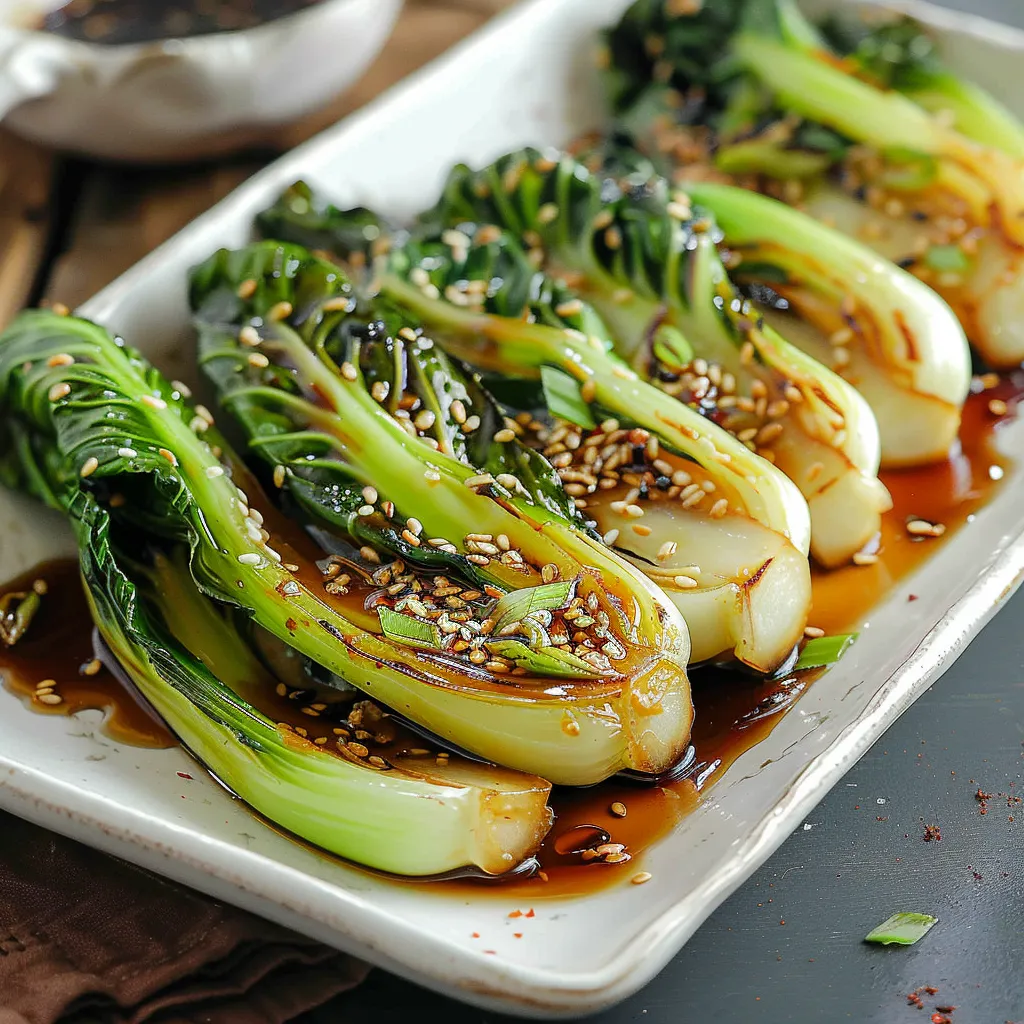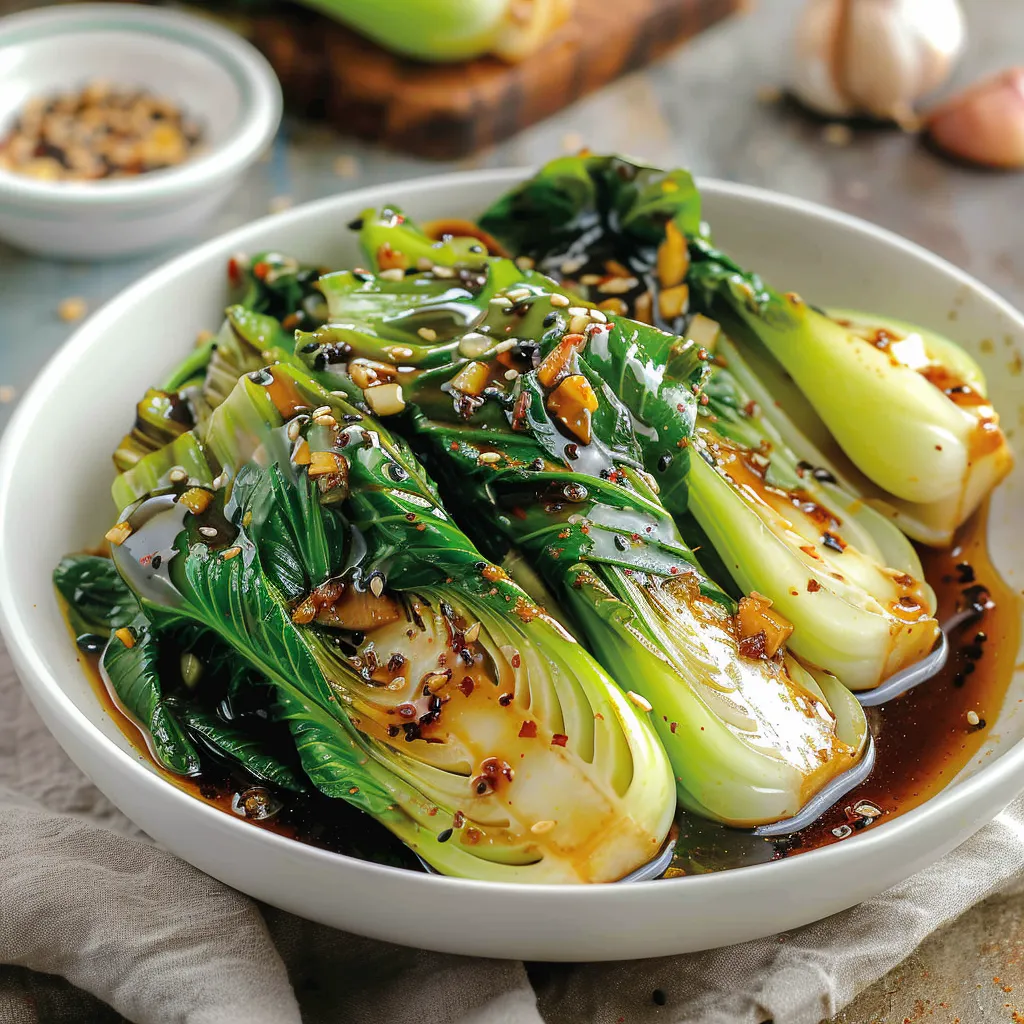 Pin to Favorites
Pin to Favorites
This baby bok choy stir-fry has become my go-to side dish whenever I'm craving something green that's packed with flavor but takes almost no time to prepare. The tender leaves and crisp stalks soak up the savory garlic and soy sauce, creating a perfect balance of textures and tastes.
I first started making this recipe when I was looking for quick vegetable sides that wouldn't overpower my main courses. Now my family requests it weekly, especially alongside rice bowls and grilled salmon.
Ingredients
- Baby bok choy: Offers a mild cabbage flavor with tender leaves and crunchy stems, look for small bright heads without wilted leaves
- Canola or vegetable oil: Works best for high heat cooking without adding competing flavors
- Fresh garlic cloves: Provide essential aromatic flavor, always mince them just before cooking for maximum impact
- Soy sauce: Brings that classic umami depth, opt for low sodium if you're watching salt intake
- Chinese mushroom sauce: Adds earthy complexity, find it in Asian grocery stores for authenticity
- Sesame seeds: Create a nutty finish and beautiful presentation, toast them lightly for enhanced flavor
- Salt and pepper: For final seasoning adjustments
- Optional red pepper flakes: Add customizable heat without overwhelming the delicate bok choy
Step-by-Step Instructions
- Blanch the Bok Choy:
- Bring a large pot of water to a rolling boil and add a generous pinch of salt. While waiting, trim the bottoms of your bok choy and separate the stalks if they're large. Prepare a bowl with ice water. Drop the bok choy into the boiling water for exactly one minute. This brief blanching preserves the vibrant green color while softening the stems just enough. Immediately transfer to the ice bath to halt cooking, then thoroughly pat dry to prevent spattering when stir-frying.
- Create the Aromatic Base:
- Heat your skillet until it's very hot before adding oil. This prevents the vegetables from absorbing too much oil and becoming greasy. Add minced garlic to the hot oil and keep it moving constantly for about 30 seconds. Watch carefully as garlic burns quickly and will turn bitter. You want it fragrant and just turning golden but not brown.
- Stir-Fry the Bok Choy:
- Add your blanched and dried bok choy to the fragrant oil, tossing continuously with tongs or a spatula. The goal is to get light caramelization on the edges while maintaining the crisp tender texture. This should take 2-3 minutes on high heat. Make sure every piece gets contact with the hot pan surface.
- Finish with Sauces:
- Pour the soy sauce and mushroom sauce directly over the vegetables and quickly toss to coat every surface. The liquid will sizzle and begin to reduce almost immediately, forming a light glaze around each piece. Continue cooking and stirring for about one minute until the sauce has slightly thickened and clings to the bok choy.
 Pin to Favorites
Pin to Favorites
The Chinese mushroom sauce truly elevates this dish from simple to special. I discovered it while shopping at an Asian market years ago, and now I keep it stocked as a pantry staple. The depth it adds to vegetables is unmatched compared to using soy sauce alone.
Perfect Pairings
This vibrant side dish complements so many Asian-inspired mains beautifully. Serve it alongside teriyaki salmon, ginger chicken, or simple steamed rice for a complete meal. The savory flavors and crisp texture provide a wonderful counterpoint to rich or spicy main dishes. I particularly love it with sticky rice and a fried egg on top for a quick weeknight dinner.
Ingredient Substitutions
If you can't find baby bok choy, regular bok choy works well but may require slicing into smaller pieces and slightly longer cooking time. For the mushroom sauce, oyster sauce makes an excellent substitute with a similar umami quality. Tamari can replace traditional soy sauce for a gluten-free version, and toasted sesame oil can be drizzled at the finish instead of sesame seeds for a more intense flavor. When garlic isn't available, a tablespoon of finely minced shallot will provide a different but complementary aromatic base.
Storage Tips
While best enjoyed immediately after cooking, leftovers can be refrigerated for up to two days in an airtight container. To reheat, a quick 30-second stir in a hot skillet works better than microwave heating, which can make the bok choy soggy. I don't recommend freezing this dish as the texture becomes mushy upon thawing. If you have extra blanched but unseasoned bok choy, it will keep well refrigerated for 2-3 days and can be quickly stir-fried when needed.
 Pin to Favorites
Pin to Favorites
This dish is a testament to how simple, fresh ingredients can transform into a flavorful and versatile side with the right technique.
Frequently Asked Questions
- → How do you prevent baby bok choy from becoming soggy?
Blanch quickly in boiling water, then immediately transfer to ice water to halt cooking. Pat dry thoroughly before stir-frying.
- → Can I use a different leafy vegetable?
Yes, similar vegetables like bok choy, spinach, or chard work well and pair nicely with the garlic and sauces.
- → What is mushroom sauce, and can I substitute it?
Mushroom sauce is a savory condiment with a rich umami flavor. Hoisin sauce or oyster sauce can be good substitutes.
- → Is this dish suitable for vegans?
Yes, as long as the mushroom sauce is vegan-friendly, this dish is entirely plant-based.
- → What pairs well with this dish?
This side dish complements steamed rice, noodles, or grilled proteins like tofu, chicken, or fish.
